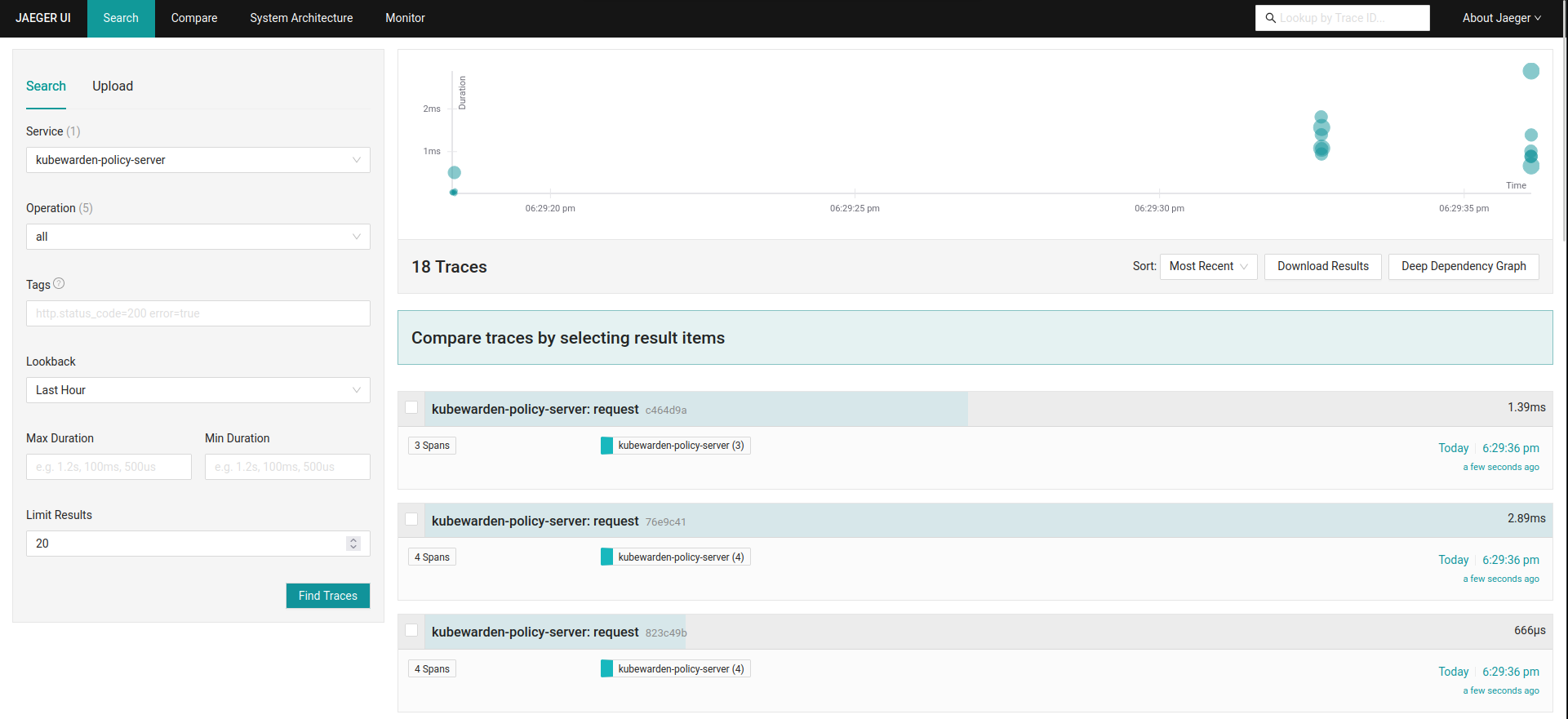Custom OpenTelemetry Collector
This guide explains how Kubewarden can be configured to send telemetry data to an OpenTelemetry collector that has been previously deployed on the cluster.
We will deploy only one instance of the OpenTelemetry Collector inside of the cluster.
Install dependencies
First, we begin by installing the dependencies of OpenTelemetry Collector.
We want the communication between the Kubewarden components and the collector to be encrypted. Hence we will leverage cert-manager to manage all the certificates required to secure the communication.
The traces collected by the OpenTelemetry Collector will be sent to a Jaeger instance.
The Kubewarden stack will send metrics to the OpenTelemetry Collector. This one will expose the metrics as a Prometheus endpoint. The metrics will then be scraped by a Prometheus instance and stored in its database. The same Prometheus instance will also expose a UI to interact with the metrics.
Some of the resources we will create are going to be defined inside of the kubewarden
Namespace, or expect its existence. Because of that, we begin by creating the Namespace:
kubectl create namespace kubewardenInstall cert-manager and OpenTelemetry
cert-manager and OpenTelemetry operator can be installed in this way:
helm repo add jetstack https://charts.jetstack.io
helm install --wait \
--namespace cert-manager \
--create-namespace \
--set crds.enabled=true \
--version 1.15.1 \
cert-manager jetstack/cert-manager
helm repo add open-telemetry https://open-telemetry.github.io/opentelemetry-helm-charts
helm install --wait \
--namespace open-telemetry \
--create-namespace \
--version 0.65.0 \
--set "manager.collectorImage.repository=otel/opentelemetry-collector-contrib" \
my-opentelemetry-operator open-telemetry/opentelemetry-operatorThe communication between the Kubewarden components and the OpenTelemetry Collector will be established using mTLS.
To do that, we need to create the whole PKI infrastructure:
# pki.yaml file
apiVersion: cert-manager.io/v1
kind: Certificate
metadata:
name: my-client-certificate
namespace: kubewarden
spec:
dnsNames:
- kubewarden.kubewarden.svc
- kubewarden.kubewarden.svc.cluster.local
issuerRef:
kind: Issuer
name: my-selfsigned-issuer
secretName: my-client-cert
---
apiVersion: cert-manager.io/v1
kind: Certificate
metadata:
name: my-certificate
namespace: kubewarden
spec:
dnsNames:
- my-collector-collector.kubewarden.svc
- my-collector-collector.kubewarden.svc.cluster.local
issuerRef:
kind: Issuer
name: my-selfsigned-issuer
secretName: my-server-cert
---
apiVersion: cert-manager.io/v1
kind: Issuer
metadata:
name: my-selfsigned-issuer
namespace: kubewarden
spec:
selfSigned: {}Apply the manifest:
kubectl apply -f pki.yamlInstall Jaeger and Prometheus
After that, we install Jaeger to store and visualize trace events.
helm repo add jaegertracing https://jaegertracing.github.io/helm-charts
helm upgrade -i --wait \
--namespace jaeger \
--create-namespace \
--version 2.49.0 \
jaeger-operator jaegertracing/jaeger-operator \
--set rbac.clusterRole=true
kubectl apply -f - <<EOF
apiVersion: jaegertracing.io/v1
kind: Jaeger
metadata:
name: my-open-telemetry
namespace: jaeger
spec:
ingress:
enabled: true
annotations:
kubernetes.io/ingress.class: nginx
EOFNow we install Prometheus to store and visualize metrics.
cat <<EOF > kube-prometheus-stack-values.yaml
prometheus:
additionalServiceMonitors:
- name: kubewarden
selector:
matchLabels:
app.kubernetes.io/instance: kubewarden.my-collector
namespaceSelector:
matchNames:
- kubewarden
endpoints:
- port: prometheus
interval: 10s
EOF
helm repo add prometheus-community https://prometheus-community.github.io/helm-charts
helm install --wait --create-namespace \
--namespace prometheus \
--version 51.5.3 \
--values kube-prometheus-stack-values.yaml \
prometheus prometheus-community/kube-prometheus-stack|
The Prometheus service monitor will obtain the Kubewarden metrics by scraping the
OpenTelemetry collector running inside of the |
Install OpenTelemetry Collector
Now we will deploy a custom OpenTelemetry Collector inside of the kubewarden Namespace.
# otel-collector.yaml file
apiVersion: opentelemetry.io/v1beta1
kind: OpenTelemetryCollector
metadata:
name: my-collector
namespace: kubewarden
spec:
mode: deployment # This configuration is omittable.
volumes:
- name: server-certificate
secret:
secretName: my-server-cert
- name: client-certificate
secret:
secretName: my-client-cert
volumeMounts:
- name: server-certificate
mountPath: /tmp/etc/ssl/certs/my-server-cert
readOnly: true
- name: client-certificate
mountPath: /tmp/etc/ssl/certs/my-client-cert
readOnly: true
config:
receivers:
otlp:
protocols:
grpc:
tls:
cert_file: /tmp/etc/ssl/certs/my-server-cert/tls.crt
key_file: /tmp/etc/ssl/certs/my-server-cert/tls.key
client_ca_file: /tmp/etc/ssl/certs/my-client-cert/ca.crt
processors: {}
exporters:
debug:
verbosity: normal
prometheus:
endpoint: ":8080"
otlp/jaeger:
endpoint: "my-open-telemetry-collector.jaeger.svc.cluster.local:4317"
tls:
insecure: true
service:
pipelines:
metrics:
receivers: [otlp]
processors: []
exporters: [debug, prometheus]
traces:
receivers: [otlp]
processors: []
exporters: [debug, otlp/jaeger]Apply the manifest:
kubectl apply -f otel-collector.yamlThe configuration above uses a trivial processing pipeline to receive trace events and to forward them to Jaeger. It also receives metrics and exposes them to be scraped by Prometheus.
The communication between the Kubewarden stack and the OpenTelemetry Collector is secured using mTLS. However the communication between the OpenTelemetry Collector and Jaeger has not been secured to reduce the complexity of the example.
Install Kubewarden stack
When the OpenTelemetry Collector is up and running, we can deploy Kubewarden in the usual way.
We need to configure the Kubewarden components so they send events and metrics to the OpenTelemetry Collector.
# values.yaml
telemetry:
mode: custom
metrics: True
tracing: True
custom:
endpoint: "https://my-collector-collector.kubewarden.svc:4317"
insecure: false
otelCollectorCertificateSecret: "my-server-cert"
otelCollectorClientCertificateSecret: "my-client-cert"The Secret referenced by the otelCollectorCertificateSecret key must have an
entry named ca.crt that holds the certificate of the CA that issued the
certificate used by the OpenTelemetry Collector.
The Secret referenced by the otelCollectorClientCertificateSecret key must have
the following entries: tls.crt and tls.key keys. These are the client certificate and
its key that are used by the Kubewarden stack to authenticate against the OpenTelemetry Collector.
These values can be left empty when no encryption is used or when no mTLS is required.
Install the Kubewarden stack:
helm install --wait \
--namespace kubewarden --create-namespace \
kubewarden-crds kubewarden/kubewarden-crds
helm install --wait \
--namespace kubewarden \
--create-namespace \
--values values.yaml \
kubewarden-controller kubewarden/kubewarden-controller
helm install --wait \
--namespace kubewarden \
--create-namespace \
kubewarden-defaults kubewarden/kubewarden-defaults \
--set recommendedPolicies.enabled=True \
--set recommendedPolicies.defaultPolicyMode=monitorNow everything is in place.
Exploring the Jaeger UI
We can see the trace events generated by Kubewarden by using the Jaeger web UI.
All of them will be grouped under the kubewarden-policy-server service:

To access the Jaeger UI, we can create an Ingress or we can do a port forwarding to our local machine:
kubectl -n jaeger port-forward service/my-open-telemetry-query 16686The web UI is going to be reachable at localhost:16686.
Exploring the Prometheus UI
The Prometheus UI can be accessed doing a port forwarding to our local machine:
kubectl port-forward -n prometheus --address 0.0.0.0 svc/prometheus-operated 9090The web UI is going to be reachable at localhost:9090.